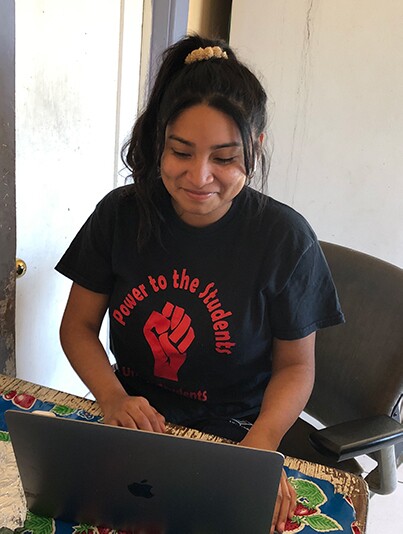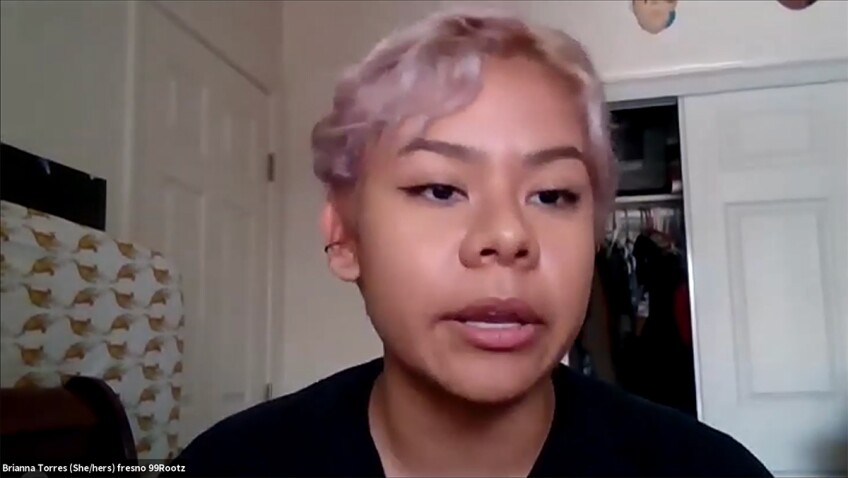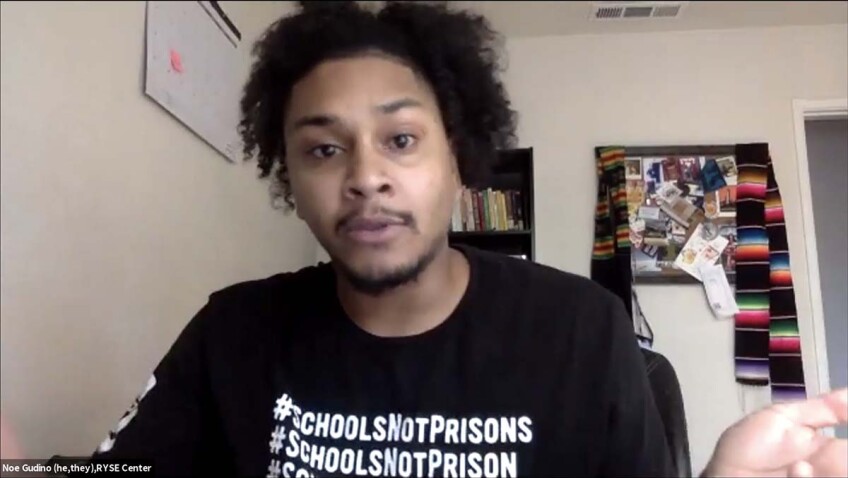For Youth Leaders, The Fight is Personal: Mobilizing for Prop 15

Note: Public Media Group of Southern California does not endorse any proposition.
When Maria Velez was in high school, she saw many things that made her realize that education is being underfunded.
Because of overcrowding, students sometimes needed to grab chairs from nearby classrooms to accommodate everyone, said Velez, of East Los Angeles.
When she was a high school senior, she encountered other problems while working on her college applications. The school had only one college advisor, who didn’t have enough time to help all the students.
Fortunately, she received help from a community youth organization, which guided her through the entire college application process.
“I received support that I couldn’t get in school,” said Velez, who is now a 19-year-old college student.
Now, she's on a mission to ensure that California schools get all the resources that they need. Velez is part of a broad coalition mobilizing voters to support Proposition 15, a measure on the November ballot that would increase property taxes on businesses.
The "Yes on 15" coalition includes various youth organizations — including Power California, Californians for Justice and GENup. The youth leaders in the movement see Proposition 15 as crucial to improving their communities.
Background on Prop. 15
Proposition 15 is intended to reform the controversial 1978 ballot measure, Proposition 13.
Under Proposition 13, residential and commercial property taxes are limited to 1% of assessed value. The value can increase by just 2% each year, or the rate of inflation (whichever is less).
According to critics of Proposition 13, the 1978 measure led to a “boom and bust” cycle for California public schools — involving declines in funding during recessions.
Proposition 15 would establish a “split roll tax” — in which business properties would be reassessed every three years based on market value, while the tax system for residential properties would be unchanged.
Commercial properties worth $3 million or less would be exempt from these requirements.
According to estimates from the California voter guide, Proposition 15 would generate $6.5 billion to $11.5 billion in new revenue each year. The measure allocates 40% of the money to schools and community colleges, and 60% to cities, counties and special districts.
If approved, the new tax system would be phased in over several years, beginning in 2022.
Evolution of the Movement
The effort to reform commercial property taxes has been years in the making, said Veronica Carrizales of California Calls, an alliance of community groups throughout the state.
“We were one of the groups that pushed for it,” said Carrizales, policy and campaign director at California Calls.
About five years ago, there were two legislative attempts at commercial property tax reform, she noted. However, those legislative proposals were ultimately unsuccessful.
Following that, activists collected signatures to get the issue on the ballot. Now, the focus is mobilizing voters to support the November ballot measure.
“Yes on 15” Campaign
The vast coalition supporting Proposition 15 includes community organizations, racial justice groups, and labor unions.
The groups providing the most contributions are:
- California Teachers Association (CTA)
- Chan Zuckerberg Initiative, formed by Facebook CEO Mark Zuckerberg and his wife Priscilla Chan
- Service Employees International Union (SEIU) California State Council
Alex Stack, a spokesman for the "Yes on 15" campaign, said the measure could help address major problems in the state.
Recently, California ranked 39th among all states nationwide in per-pupil spending, he noted. The effects of this underfunding can be seen in many ways, including the overcrowded classrooms in many public schools, according to Stack.
Meanwhile, California also has “some of the worst rates of poverty and homelessness and inequality in the country,” he said.
A UCLA study released in October reveals the extent of student homelessness. In an analysis of recent data, the researchers found that more than 269,000 youths in grades K-12 are homeless.
The problem also affects college students. According to the UCLA study, 20% of community college students are homeless. In the California State University system, it’s 10%. Also, 5% of students at the University of California system are homeless.
According to Stack, the tax system created by Proposition 13 places an unfair burden on young people. For instance, students often must deal with inadequate school supplies — including out-of-date textbooks and not enough hand soap.
“They are the ones who are significantly disadvantaged under the current system,” he said.

In 2020, the COVID crisis has highlighted other inequities in the system, such as the “digital divide,” he added. As California schools have shifted to remote learning, many students in low-income communities have struggled with inadequate technology at home.
Supporters of Proposition 15 are tired of the status quo, Carrizales emphasized. They’re frustrated with the underfunding of schools and community programs, and they see the ballot measure as the solution, she said. Meanwhile, many youth leaders and their families are dealing with layoffs and other economic problems during the pandemic.

With Proposition 15, young people feel they have an opportunity to shape a new future for the state.
“They want to see corporations pay their fair share,” Carrizales said.
Alvin Lee, executive director of GENup, said that companies have a responsibility to give back to society. He noted that businesses use crucial infrastructure, which has been funded by taxpayer money over the years. This includes the roads they use to transport products to market.
The "Yes on 15" campaign occurs amid the backdrop of many simultaneous crises, said Saa'un Bell, strategy director at Californians for Justice.
Those crises include the pandemic, the recession, climate change, racial inequality and voter-suppression efforts.
Proposition 15 would help residents during these struggles, according to Bell. For example, it would help in the battle against devastating wildfires, which have been intensified by climate change. Among other things, the measure would increase resources for fire departments in California.
Mobilization Techniques
The campaign has a multi-faceted approach to get out the vote — which includes phone banking, texting, social media, and online press conferences.
Phone conversations with voters are crucial, and many mobilization efforts are underway. For instance, California Calls is part of the "Million Voters Project," in which thousands of volunteers are making phone calls to urge support for Proposition 15. The callers can reach voters in seven different languages, Carrizales said. Many of the volunteers are between the ages of 18 and 25.
In addition to advocating for Proposition 15, callers also are educating people about their voting rights.
“People are worried about voter suppression and not being able to vote,” Carrizales observed.
She added: “We educate voters, so they know about all voting options.”
Regarding social media, Bell noted that many young people get their news from sites such as Instagram, TikTok and Twitter. As part of the social media component, activists have been discussing Proposition 15 with young people on Instagram Live.
Youth Activists
For Velez, the campaign is about trying to fight inequities in society. “I am really motivated to work on Proposition 15,” she said.
During her phone banking shifts, she discusses the benefits of the measure, and she informs people about their voting options.
“We do highly encourage them to vote early,” Velez said.
Another young person involved in phone banking is 17-year-old Long Beach resident Stephanie Hernandez, a member of Californians for Justice.
Hernandez, a local campaign intern, said that Proposition 15 would generate much-needed money for books, computers and other school supplies. The benefits would also extend to other parts of the community — including money to fix potholes in streets, she added.

Meanwhile, a group of youth leaders recently held an online press conference, describing their role in the movement. They’re participating in a mobilization effort run by Power California — with a goal of spurring at least 150,000 young voters into action.
The October 21 media event featured speakers from both urban areas and rural areas, discussing why Proposition 15 is important to them.
One speaker was 27-year-old Noe Gudino, voter engagement coordinator at the RYSE Center in Richmond. According to Gudino, big companies have avoided paying their fair share in taxes for decades, at the expense of schools. Youth organizers are calling voters every night, explaining details of the ballot measure, and trying to counter misinformation.
“We must fight for the future,” he said.
Brianna Torres, a youth activist at 99Rootz in Fresno, also discussed the need for more community resources.
Torres, 18, said that the COVID crisis has made the situation even more dire. During the event, she called for greater investment in education and other services.
Another speaker was Tanness Walker, a 23-year-old youth leader from the Community Coalition in South Los Angeles.
Walker is juggling work responsibilities with her college work, aiming to graduate with a psychology degree. Many young people have a responsibility to help their families, she noted. But young people need more community resources, and it’s time for businesses to pay more to help society, she said.

Responding to Opponents
The "Yes on 15" campaign faces a huge wave of opposition from business organizations and taxpayer-rights groups.
The critics argue that the impact of Proposition 15 wouldn’t be limited to huge corporations. According to the opponents, higher property taxes would be passed on to small businesses that rent space in shopping centers or other locations. The result would be layoffs and higher consumer prices, according to critics.
However, Proposition 15 supporters are countering this argument. They reference an analysis by Beacon Economics, which found that many of the opponents’ concerns are unwarranted. According to the study, commercial rents are primarily determined by conditions in local markets – and it’s unlikely that Proposition 15 would hurt small businesses.
Overall, the research shows that the burden of Proposition 15 would fall on the largest corporations, according to Stack.
This article is a series companion to the documentary “City Rising: Youth & Democracy” funded by The California Endowment.
Top Image: Power California Field Director Mynor Godoy assists volunteer phone bankers at a GOTV event in Los Angeles in February 2020 | Jay Banks




